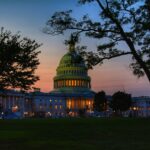July 4th Marks Halfway to Midterms
July marks the start of 4th of July BBQs, hot summer nights, and the more than halfway point of the 2022 Primary Election Season. Depending on where you live, your state’s primary election season may already be over, and candidates will be gearing up for the 2022 general election in November. However, whether it’s a Presidential election year or the midterms, state primaries are as important, if not more, than the general election in determining who will serve as elected representatives.
Compared to other western countries, the United States has lower voter turnout rates. Primary elections historically have even lower turnout rates than general election rates and midterm years have even lower rates than presidential years. During the 2014 midterms, Texas had a dismal 28.3% voter turnout in the general election compared to 51.4% in the 2016 presidential election. For the United States as a whole, the 2018 and 2020 elections both saw an increase in voter turnouts in the general election, at a turnout of 50% and 66.7% respectively.
So why the low turnout? Part of the reason is the competitiveness of the election and the personalities of the candidates— voters are more likely to participate in highly publicized elections, such as the 2020 Presidential Election which had the highest voter turnout of the 21st century. Voters felt like they had to pick between the lesser of two evils in 2020, and campaign messaging surrounding important issues such as the COVID-19 pandemic, race relations in the U.S., and the Supreme Court rallied voters to have a high turnout on Election Day.
Another reason is that primaries in each state are not on the same day, compared to having a nationwide Election Day for the general election. Each state also has a different way of conducting primaries; a state can have a closed primary, partially closed, partially open, open to unaffiliated voters, open, or use a top-two system. States can also have different primary rules for state elections versus a presidential one, all of which can greatly confuse voters and lead them not to vote to avoid the hassle and confusion.
For those that do choose to vote in the primaries, voters tend to be highly partisan in what is known as the “primary problem.” In 2020, 83% of districts were labeled as safe, meaning that voters have less of an incentive to vote in the general election and the winner is actually determined in the primary. When asking how candidates like Ilhan Omar in 2018 and Marjorie Taylor-Greene in 2020 won their general election, voters can look to the primaries. Each candidate won their party’s nomination after competing against a large candidate field, and, since each lived in a safe district, easily won the general election.
Because multiple candidates are competing to be the party’s nominee, this can also cause candidates to take more extreme positions to stand out in a competitive field. Candidates like Donald Trump, Alexandria Ocasio-Cortez, and Lauren Boebert did well in the primaries because they took more extreme positions and appealed to the voters who tend to turn out in primaries.
In 2016 for example, voters who described themselves as “Strong Republicans” or “Strong Democrats” had a 60% turnout in the primaries. Weak Democrats, Weak Republicans, and Independents each had a 30% turnout, meaning that the more ideologically extreme candidate is more likely to win the primary compared to a more ideologically moderate candidate. This is also compounded by the fact that independent voters cannot vote in 10 states that have closed primaries; for the 11 million independent voters in 2020 that lived in closed primary states, they were unable to have any influence on electing a more ideologically moderate candidate.
Finally, incumbents also hold a substantial advantage in being reelected. Since 1964, the House has seen reelection rates over 80% and the Senate has seen rates over 50%. Incumbents benefit significantly from name recognition, which in turn leads to greater fundraising numbers and the likelihood that someone who hasn’t been closely following the race will vote for them. This contributes to what’s known as Fenno’s paradox, where voters approve of their own representative more than Congress as a whole. When voters feel that their representative is meeting their district’s or state’s needs, they have a favorable view of their representative and are not likely to vote them out in a primary. In safe districts though, this can lead potential candidates to be more ideologically extreme to balance out and beat the advantages that an incumbent has.
Will the 2022 Midterms continue to follow these trends? Even with several primaries still left, voter turnout and outcomes will likely follow the patterns of the last decade. Whether it’s wanting younger, more ideologically moderate, or more diverse candidates, voters should remember that while Election Day may be the more memorable day that’s marked on their calendars, their state primary day is the one that has the greater impact in shaping the U.S. political climate.




